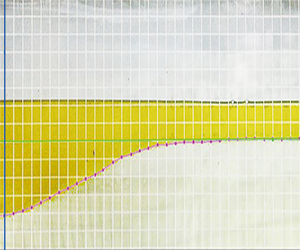Article contents
Experimental and numerical studies on internal solitary waves with a free surface
Published online by Cambridge University Press: 21 July 2020
Abstract

Large-amplitude internal solitary waves in a two-layer fluid system with a free surface are investigated in this paper. Laboratory experiments on strongly nonlinear internal solitary waves with a free surface for a deep configuration are conducted. After comparing the experimental data with the results of the Miyata–Choi–Camassa model that includes the free-surface effects (MCC-FS), we find that the MCC-FS model does not calculate accurately the internal solitary waves with a free surface. Thus, we develop a strongly nonlinear model for a deep configuration, namely the two-layer high-level Green–Naghdi (HLGN-FS) model that includes the free-surface effects. Numerical results of the HLGN-FS model, including the wave profile, velocity field and wave speed, are presented for three cases. The first case is a shallow configuration with  $\rho _{2}/\rho _{1}=0.977$ and
$\rho _{2}/\rho _{1}=0.977$ and  $h_{2}/h_{1}=1/4.13$, where
$h_{2}/h_{1}=1/4.13$, where  $\rho _{2}$ and
$\rho _{2}$ and  $\rho _{1}$ are the densities of the upper-fluid layer and the lower-fluid layer, respectively, and
$\rho _{1}$ are the densities of the upper-fluid layer and the lower-fluid layer, respectively, and  $h_{2}$ and
$h_{2}$ and  $h_{1}$ are the depths of the upper-fluid layer and the lower-fluid layer, respectively. The second case is also a shallow configuration, where
$h_{1}$ are the depths of the upper-fluid layer and the lower-fluid layer, respectively. The second case is also a shallow configuration, where  $h_{2}/h_{1}=1/5$ while
$h_{2}/h_{1}=1/5$ while  $\rho _{2}/\rho _{1}=0.859$. The third case is related to the present physical experiments, where
$\rho _{2}/\rho _{1}=0.859$. The third case is related to the present physical experiments, where  $\rho _{2}/\rho _{1}=0.869$ and
$\rho _{2}/\rho _{1}=0.869$ and  $h_{2}/h_{1}=1/15$. It is shown that the MCC-FS model can provide accurate results for the shallow configurations. Meanwhile, the HLGN-FS model is shown to be accurate for describing the internal solitary waves for both shallow and deep configurations.
$h_{2}/h_{1}=1/15$. It is shown that the MCC-FS model can provide accurate results for the shallow configurations. Meanwhile, the HLGN-FS model is shown to be accurate for describing the internal solitary waves for both shallow and deep configurations.
- Type
- JFM Papers
- Information
- Copyright
- © The Author(s), 2020. Published by Cambridge University Press
References
REFERENCES
- 14
- Cited by




